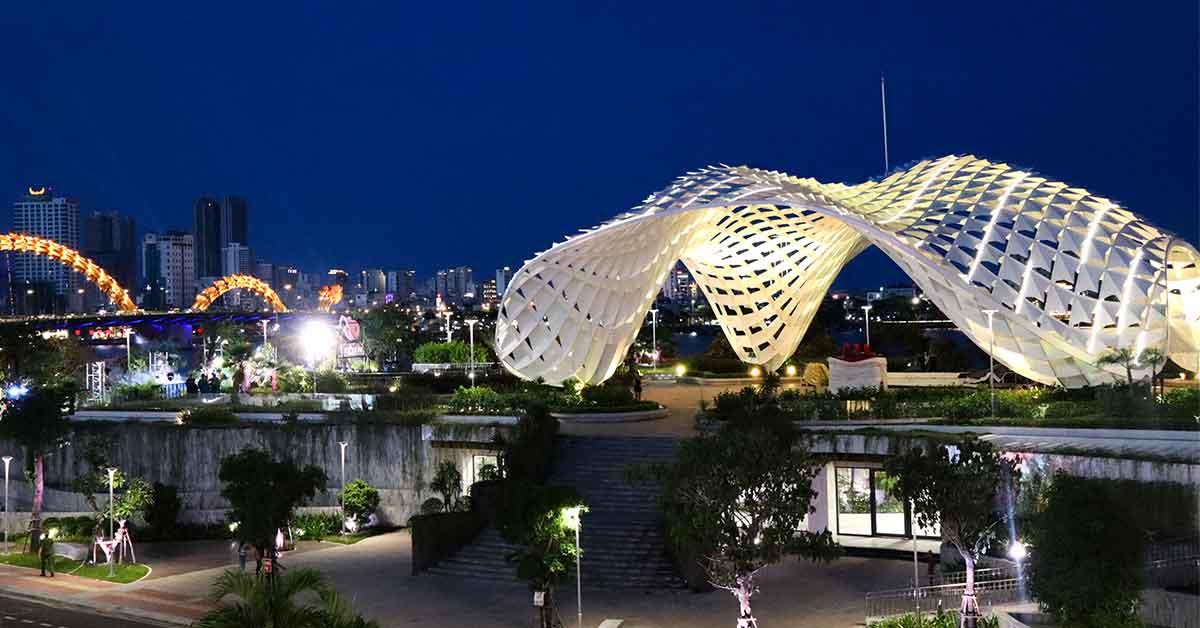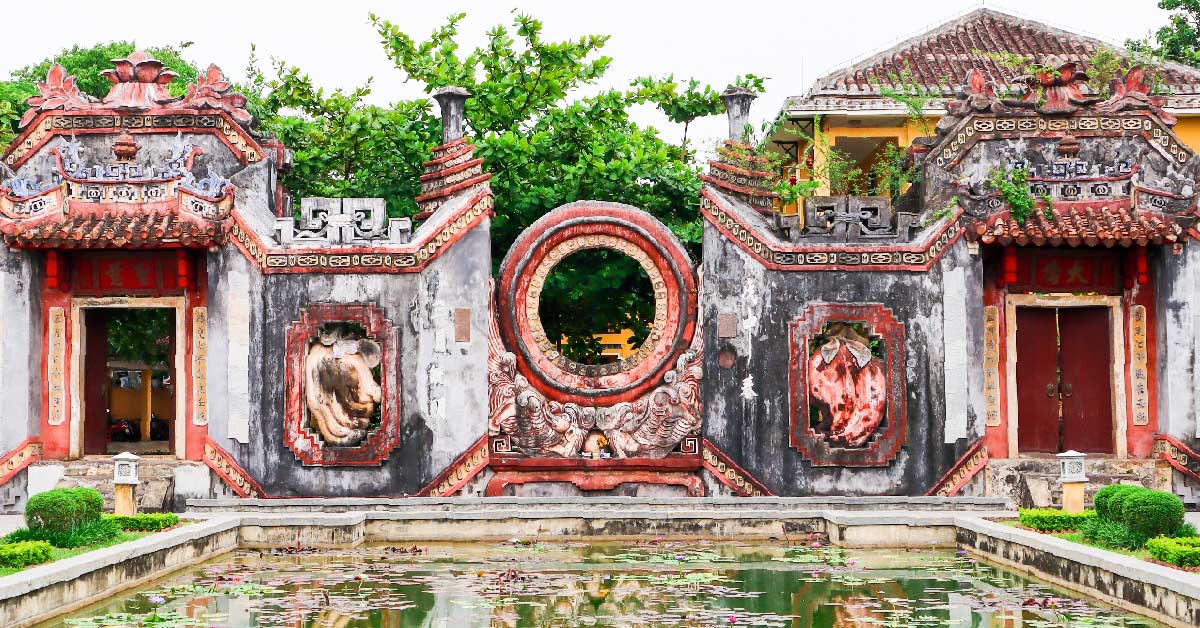Where to See a Whirling Dervish Show in Istanbul & Is It Worth It?
Where to watch whirling dervishes in Istanbul: is the dervish experience worth it? A guide to the top spots for dervish performances, with tips on booking show tickets and making the most of your visit.
Mevlevis or the whirling dervishes of Istanbul caught in an endless spin… What a sight!
A timeless journey of contemplation and connection to the divine, the Sufi whirling dervish dance is one of Istanbul’s most mesmerizing cultural and spiritual experiences.

“Those who turn in the direction of prayer,
whirl in both this world and the next.
Pay heed when a circle of friends whirl,
circling round and round, the Kaaba is the center.“
Jalaluddin Muhammad Balkhi Rumi, Persian poet, Sufi mystic, and theologian, on the whirling dervishes in “Divani Shamsi Tabriz“
What is the deeper significance behind the dervishes’ graceful movements? How do the teachings of the 13th-century Persian poet and mystic Rumi inspired this tradition? Why is a whirling dervish show truly worth your time?
Below, all the reasons you should not skip it when visiting Istanbul.
Disclosure: This article contains affiliate links. If you make a purchase after clicking one of these links, I earn a small commission from that website at no extra cost to you. Learn more: Disclosure policy.
 What is a Whirling Dervish?
What is a Whirling Dervish?
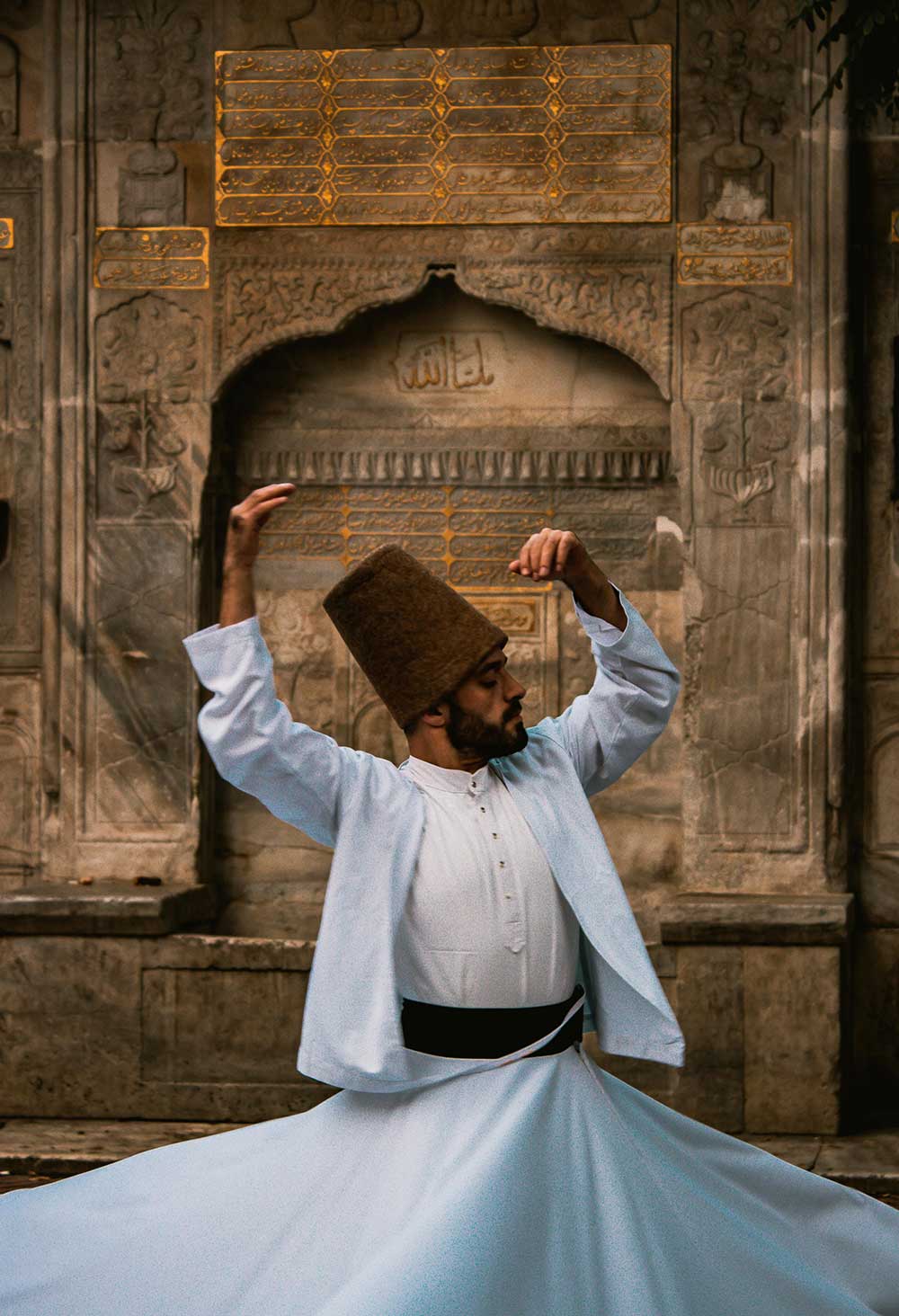
Whirling Dervish in Istanbul, Copyright © Emir Eğricesu
Have you ever wandered Istanbul to come across this unusual individual wearing a tall conical hat and dressed up in a flowing white robe, gracefully spinning in circles. That mesmerizing sight is of a whirling dervish during his spiritual ritual that looks like a dance, but is actually a form of meditation.
A whirling dervish is a practitioner of a form of Sufi worship known as the Sema ceremony, which is deeply rooted in the mystical branch of Islam called Sufism. The dervishes in Istanbul are members of the Muslim Mevlevi Order, which was founded by the followers of the 13th-century Persian poet and mystic Rumi. They follow his philosophy of love, selflessness, and the pursuit of divine truth.
The name “dervish” originates from the Persian word “darvish,” meaning “door sill” or “fakir,” and referring to a person who renounces the material world and dedicates himself entirely to God.
The most iconic aspect of his worship is the whirling dance, where the dervish spins in repetitive circles as a form of spiritual meditation. He spins to achieve a state of spiritual ecstasy and connect with the divine.
The movement symbolizes the rotation of the planets around the sun and the dervish’s journey toward enlightenment. His right hand is often pointed upwards to receive blessings from God, while the left hand points downward, symbolizing the transmission of these blessings to the earth.
The Sema Ceremony itself is a combination of rhythmic spinning, chanting, and music, and both a physical and mystical journey, meant to purify the soul, transcend the ego, and fulfil a deep connection with the divine presence, in harmony and balance.
📌 Important: Sema Ceremony of the Mevlevi order is a UNESCO-protected cultural practice, and watching it is one of the most unique things to do in Istanbul.
 What to expect from a Whirling Dervish Show in Istanbul?
What to expect from a Whirling Dervish Show in Istanbul?
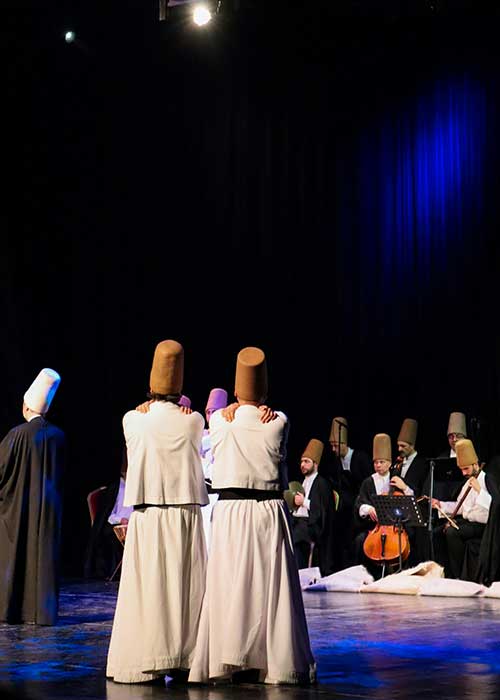
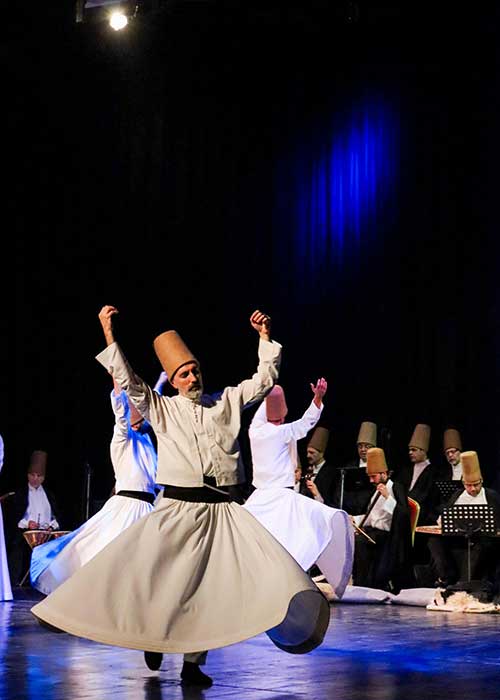
All authentic Dervish experiences in Istanbul last about one hour. During this time, you will watch Dervishes slowly moving in circles, repeatedly, in a solemn atmosphere.
Depending on your expectations, Sema ceremony can either be a magical experience that hypnotizes you or might come across as uneventful and even a bit boring.
Therefore, it is better to know from the start that this is not meant for entertainment in the fun way. As a deep spiritual practice, it is a form of meditation and worship rather than a lively show.
However, for those who appreciate symbolism and cultural significance, the Turkish whirling dervishes’ shows give a precious insight into a rare Turco-Persian medieval tradition not only mesmerizing, but also deeply meaningful.
Sufi Dance in Istanbul: The Sema Ceremony
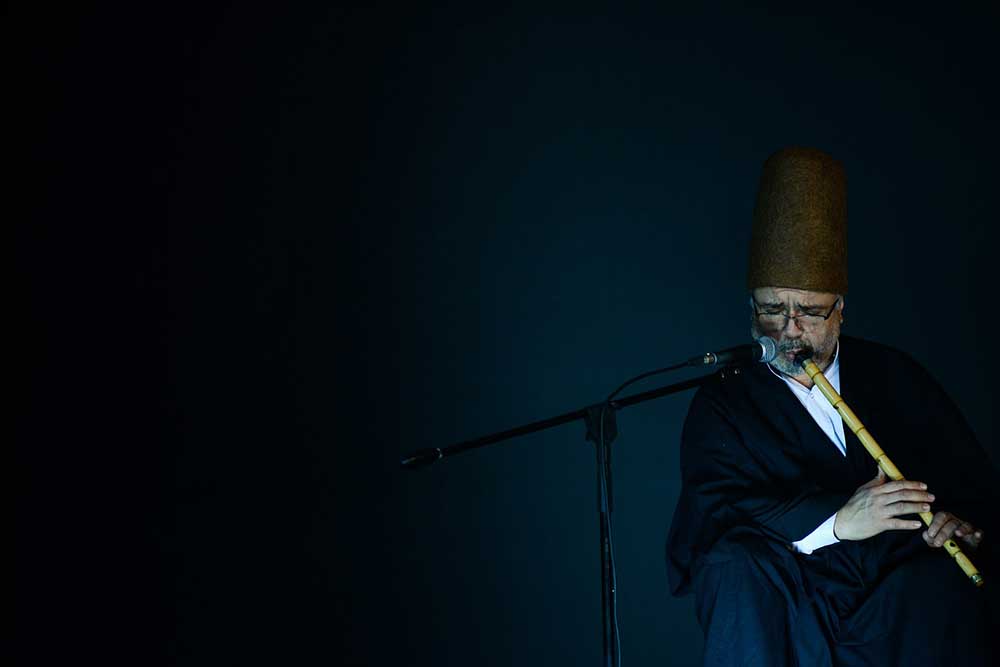
Sufi Song, Copyright © Ali Murtaza
There are seven stages of the Whirling Dervishes’ Sema ceremony that lead the practitioner towards spiritual perfection, each with a deep significance of its own.
The Naat-i Sharif, a chant honouring Prophet Muhammad, opens the ritual. Following this eulogy, there is the sound of a drum, which signifies the heavenly command “Be“, and then is the Taksim, a solo improvisation on the ney (a traditional Turkish reed flute), which represents the holy breath that gives life to everything in the universe.
During the fourth stage, Devr-i Veled, the dervishes greet one another and walk in a circular procession, spinning three times, recreating a mystical image of a universe that slowly forms itself, with the planets orbiting the sun.
The core of the whirling dervishes’ performance, the fifth part, in which they revolve around their own axis, while maintaining the original circle, is linked to of The Four Salams:
- Acknowledgment of the presence of God.
- Rapture of the human being at the greatness of God and creation.
- Rapture is transformed into togetherness and love.
- Peaceful readiness to serve. Embracing one’s own fate.
A brief prayer from the Quran is said after the four salams, then Fetiha is read to conclude the ceremony.
Music, Costumes, and Dance
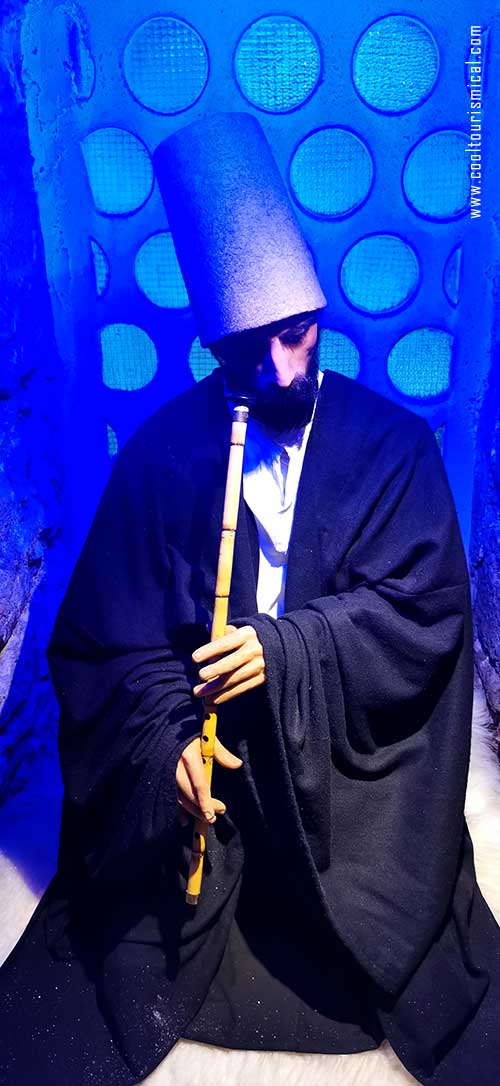
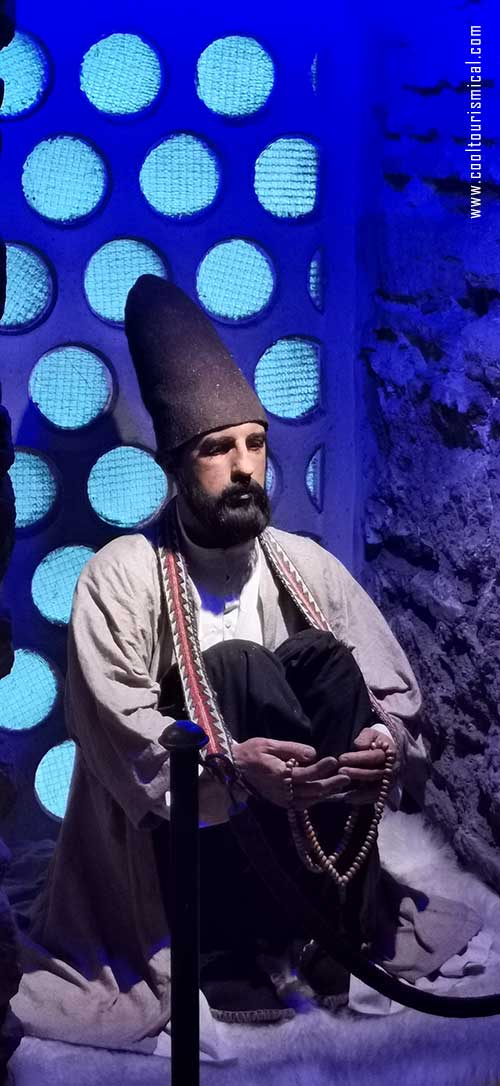
Statues of the Mevlevi Dervishes at Hodjapasha, Instanbul, Copyright © Cooltourismical.com
What we often understand as a mesmerizing dance of the whirling dervishes is actually a form of active meditation. Their almost magical, continuous spinning, without any trace of dizziness, represents the dervishes’ detachment from the material world.
They gracefully raise their right arm, with the palm towards the sky, waiting to receive God’s blessings. Their left hand points downwards, transferring the divine energy to the earth. And their eyes are often half-closed, focusing on oneself.
The Dervishes’ dance has traditional Sufi music in the background to help them achieve a unique meditative state of introspection. Chants and hymns, often poems by the 13th-century mystic Rumi, add more layers to the ceremony. They use instruments like the ney (reed flute), kudüm (small double drum), kanun (plucked zither), and rebab (bowed string instrument).
Their attire is also rich in symbolism. The tall brown felt hat (Sikke) is the tombstone of the ego, while the white gown (Tennure) represents its shroud. As they spin, the white gowns puffing up mirror the rotation of the cosmos. The black cloak (Hırka), portraying the grave, is removed at the start of the dance, as a metamorphosis for spiritual rebirth.
A Hypnotizing Ambiance
The atmosphere during a Whirling Dervish performance is solemn and contemplative, trying to put you into a trance. You are encouraged to maintain silence, refraining from applause until the ceremony concludes, to respect the ritual’s sanctity. The lighting is usually dim, focusing attention on the performers and enhancing the spiritual mood.
 The Best Places to See Whirling Dervishes in Istanbul
The Best Places to See Whirling Dervishes in Istanbul
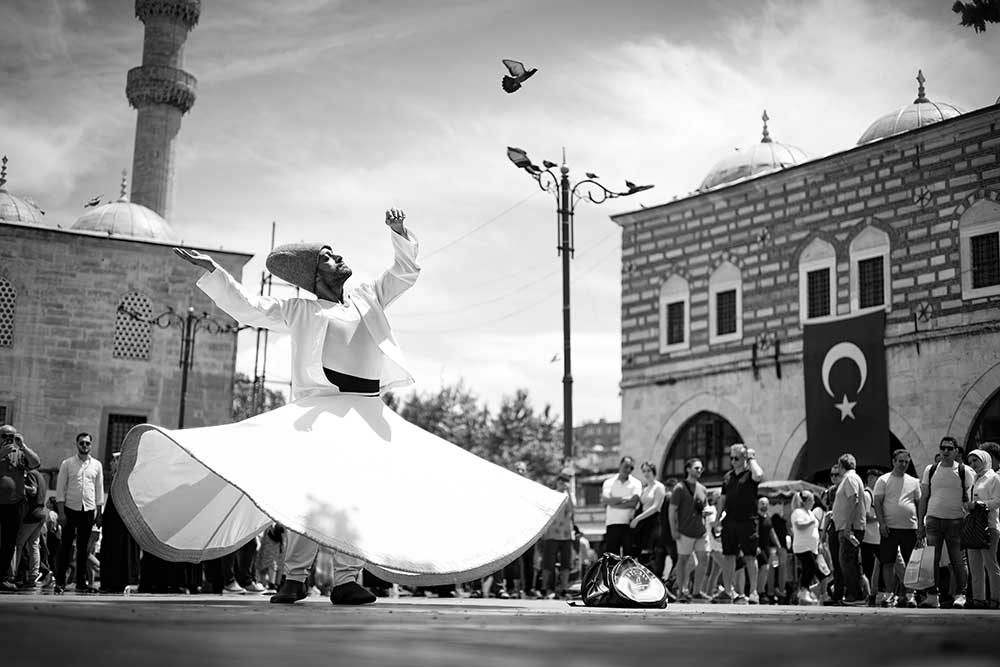
Dervish dancing near the Mosque, Copyright © Emrah Yazıcıoğlu
Wondering where is the best place to see Whirling Dervishes in Istanbul?
Once upon a time, Dervishes trained and performed their rituals only in ancient lodges, built specially with this purpose. It is said to have been five such venues around Istanbul. Today, only two of these historic sites, Galata Mevlevihanesi and Yenikapı Mevlevihanesi, continue to host authentic performances.
Moreover, throughout the years, the Sema ceremony expanded beyond the walls of lodges, and reached cultural centers, monasteries, hidden courtyards, and public squares, as a way of sharing God’s spiritual gift to the people of all backgrounds.
For those seeking the true essence of this sacred ritual, the traditional settings remain the most genuine for a dervish show.
However, if by chance you’re not deeply interested in the spiritual aspect, there are also more commercial options such as restaurants and Bosphorus cruises. They offer especially for tourists shorter performances, a blend of culture and entertainment in a more easy-going atmosphere .
Hodjapasha Cultural Center
Hodjapasha Cultural Center is known among Istanbul tourists as one of the most popular venues for witnessing the Sufi whirling dervishes. And also as one of the most beautiful, historical places.
It is located inside an ancient, 15th century traditional bathhouse, with high, domed ceilings and stone walls, rarely pierced by small windows, looking almost like a fortress.
Perfect, intimate setting for such spiritual performances!
- 📌 Location: Hoca Paşa, Hocapaşa Hamamı Sk. No:3, 34110 Fatih/İstanbul, Turkey, Google Maps;
- ⏰ Performance Schedule: every day at 07:00 PM; Duration: 1 hour.
- 🎟️ Admission: you can book your tickets in advance here. Or combo ticket (Hodjapasha, plus a 130-year-old kebab restaurant), here.
Galata Mevlevi Museum
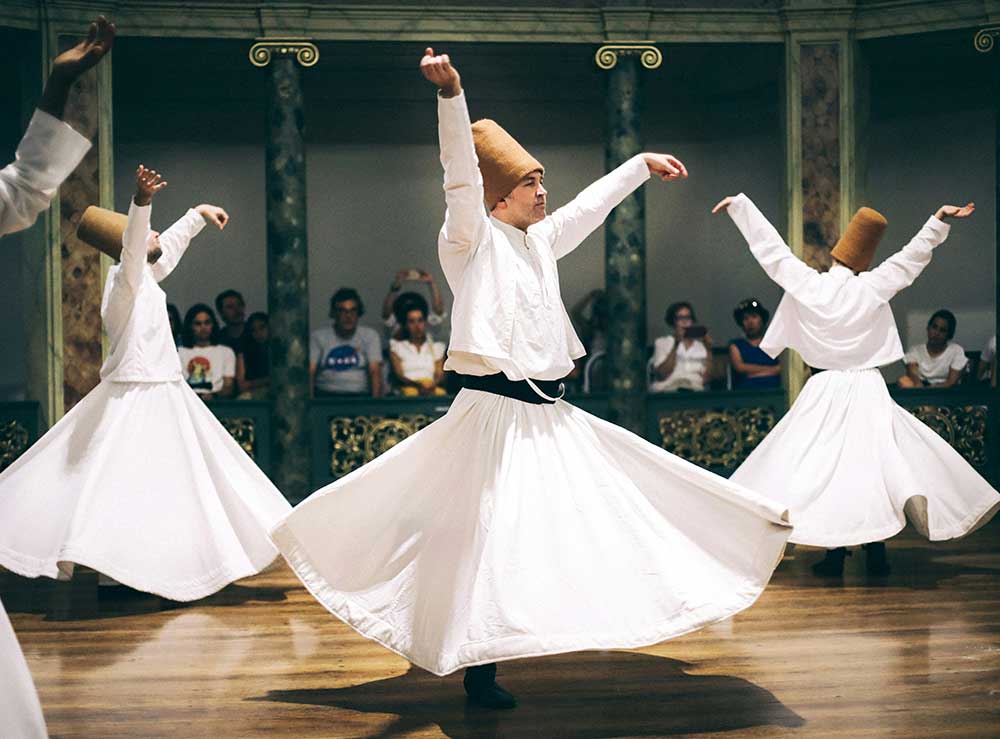
Galata Mevlevi Lodge, Istanbul, Copyright © svklimkin
Originally built in the 15th century with the purpose of spiritual training and practice of the Sufi followers, this is one of the oldest Mevlevi lodges in Istanbul. It’s a place where, despite the passage of hundreds of years, tradition and history are still very much alive.
The Sema ceremonies are held in the grand hall of the ancient building, which is designed to resemble a small, intimate theatre. The octagonal room has beautifully polished wooden floors and intricate Ottoman-style decorations. The ceremony stage is separated from the spectators’ seating area by pillars and wooden panels, with a wonderful central chandelier hanging above the whirling dervishes.
Nowadays, Galata Mevlevihanesi also functions as a museum with mystical artefacts that delve thoroughly into one of the most fascinating facets of Istanbul’s religious history: context and background on the Mevlevi order and the whirling dervishes.
- 📌 Location: Şahkulu Mahallesi, Galipdede Caddesi, No:15 Tünel, Beyoğlu, Istanbul, Google Maps;
- ⏰ Performance Schedule: Sundays, at 6:00 PM.
- 🎟️ Admission: you can book your tickets in advance here. But most of the time, they are sold out.
Yenikapı Mevlevihanesi
The Yenikapı Mevlevihanesi, also known as the New Gate Mevlevi Lodge, is another historic site where you can experience an authentic dervish ceremony. The lodge is a stunning example of Ottoman architecture, adding a lot to the overall experience.
Istanbul once had five Mevlevi lodges, and the second largest, Yenikapı, was built in the 16th century to train and educate dervishes. Over the next 300 years, it became renowned for training musicians, poets, calligraphers, marbling artists, and more. It was considered the school of fine arts and the conservatory of music during that time.
Originally, Yenikapı covered more than 77 acres, but unfortunately, it now spans only 7 acres. Like Galata, Yenikapı was known as an “asitane,” meaning the main Mevlevi lodge.
- 📌 Location: Merkezefendi Mah. Fatih Sultan Mehmet Üniversite Kampüsü, Google Maps;
- ⏰ Performance Schedule: Temporarily closed.
Sirkeci Railway Station
Les Arts Turcs Cultural Center occasionally hosts Whirling Dervish performances inside the stunning Sirkeci Railway Station, a historic landmark that once served as the terminus of the famous Orient Express.
The dervishes whirl in the grand hall, surrounded by late 19th-century Ottoman architecture. The elegance of the high ceilings and large arched windows that flood the space with natural light, and of the walls adorned with intricate tile work and stained glass make it an unusual, still interesting backdrop for the ritual, bringing together spirituality and old Instabul charm.
Less intimate, but still a genuine experience.
- 📌 Location: Hocapaşa Mahallesi Ankara Cadddesi,Halil Lütfü 4. İş Merkezi K: 1 No:113,Hoca Paşa, Google Maps;
- ⏰ Performance Schedule: Temporarily closed due to restauration.
Kızlarağa Medresesi
Kızlarağa Medresesi is a historic Ottoman-era building located in Istanbul’s Alemdar area. Originally built in 1582, the medrese (Islamic school) once served as a center for religious and scholarly learning. The architecture of the place features classical Ottoman structure and details, with its courtyard, arched colonnades, and domed halls.
Today, Kızlarağa Medresesi has been repurposed as a cultural center, offering various workshops and art exhibitions, particularly focusing on traditional Turkish arts such as calligraphy, marbling (Ebru), ceramics, and, of course, Dervish dance performances.
- 📌 Location: Alemdar, Hoca Rüstem Sk. No:6, 34110 Fatih/İstanbul, Türkiye, Google Maps;
- ⏰ Performance Schedule: Daily, at 07:00 PM and 08:30 PM; Duration: 1 hour.
- 🎟️ Admission: you can book your tickets in advance here.
Monastery in Fatih – Les Arts Turcs
Les Arts Turcs is a well-known cultural organization in Istanbul that offers a variety of experiences centered around Turkish art and tradition, workshops and performances, including Whirling Dervish ceremonies.
Their Sema ceremony takes place in a real monastery in the residential area of Fatih. Although the venue is not as spectacular or grand as the others, it allows for one of the most in-depth experiences for understanding the Dervish tradition.
For almost two hours, you can learn about the Sufis and their communities in Istanbul, as they exist today: meet the local Sufi community, explore their monastery, listen to their music, and witness the captivating Whirling Dervishes ceremony first-hand.
- 📌 Location: Fatih / ISTANBUL;
- ⏰ Performance Schedule: Thursdays, at 08:30 PM; Duration: 2 hours.
- 🎟️ Admission: ticket office location.
Cafes and Restaurants
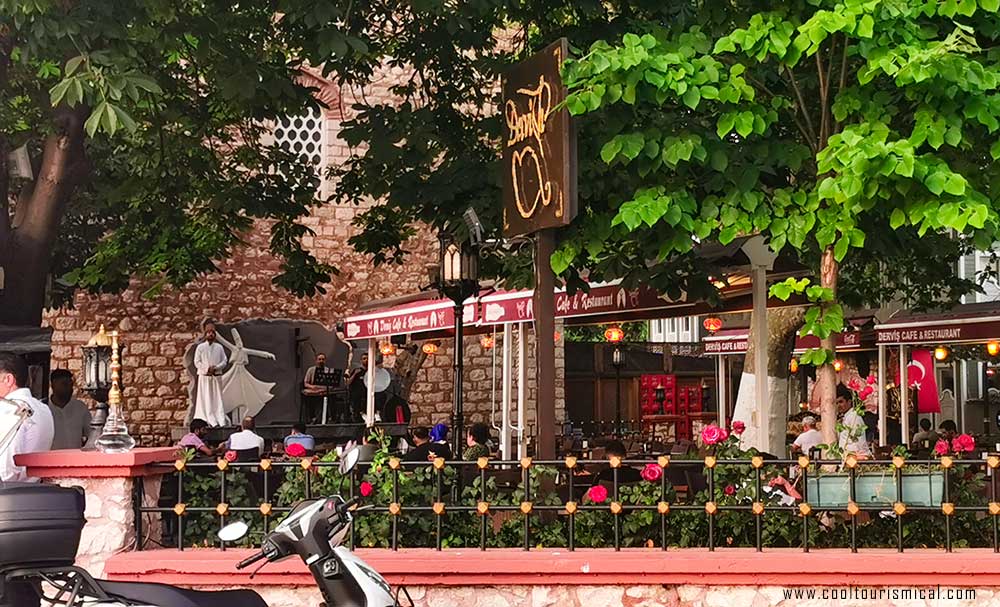
Whirling Dervishes at Dervis Café & Restaurant in Istanbul, Copyright © Cooltourismical.com
Apart from cultural centers and historical lodges, several restaurants and cafés in Istanbul also include mesmerizing Whirling Dervish performances as part of their dinner shows or cultural programs, particularly in the Sultanahmet area. Examples could be Dervis Cafe & Restaurant, Mesale Cafe, and Dervis Cafe 2.
This is for sure a more accessible and tourist-friendly way to experience the Whirling Dervish ceremony, blending Istanbul’s traditional and culinary experiences in a relaxed, casual setting — especially if you’re not deeply focused on the spiritual aspect.
Bosphorus Cruise
Although a bit more commercial and tailored for the tourists who who may not have the time to attend a traditional ceremony or who prefer a more laid-back environment, seeing Whirling Dervishes during a Bosphorus cruise in the evening can still be a truly unique and memorable experience.
The contrast between the spiritual depth of the ceremony and the lively, bustling city in the background adds a special touch to the experience. You’ll witness the traditional Sufi ritual while passing by iconic landmarks such as the Dolmabahce and Beylerbeyi Palaces, Rumeli Fortress, Kız Kulesi ( Maiden’s Tower, a historic lighthouse), Ortakoy and Uskudar ancient neighborhoods. and the Bosphorus Bridge, all lit up in their evening glow.
I tried this myself with a group of friends. we had our own table, food was average, but it definitely was a beautiful introduction to the Whirling Dervishes (and other traditional dances) with the added magic of Istanbul’s Bosphorus straight at night.
- 📌 Start time: between 08:30 PM and 10:00 PM;
- ⏰ Included: dinner, entertainment, pick-up and drop-off ;
- 🎟️ Admission: starting from around $35/ person.
 Is a Dervish Show in Istanbul Worth It?
Is a Dervish Show in Istanbul Worth It?
Well, that’s a good question. And the most appropriate answer is that it depends… Mostly on your interests and expectations from seeing a dervish dance.
The Sema ceremony, performed by the Whirling Dervishes, is a spiritual ritual deeply rooted in Sufism, and not an entertainment show in the traditional sense.
So, here’s why it might be worth it. First of all, it’s an open window towards Turkish and Islamic spirituality, particularly the mystical branch of Islam known as Sufism. The ceremony is deeply rooted in the teachings of the famous poet and mystic Rumi, providing a unique connection to the region’s rich history and philosophy.
Secondly, the graceful spinning of the dervishes, clad in flowing robes, accompanied by traditional live music, is visually captivating, mesmerizing and meditative, a spiritual experience, both beautiful and meaningful. Its purpose is to lead you into a state of contemplation and introspection.
Why It Might Not Be for Everyone? Just so you know from the start, the Whirling Devish performance is clearly not entertainment-focused. There is nothing fast-paced or high-energy. Therefore, you might find it slow or boring, as it is, as I said before, more of a meditative ritual than a lively show. It’s deeply spiritual and symbolic, which may not appeal to those who aren’t particularly interested in the religious or mystical aspects.
📌 Important text: Usually, when the Whirling Dervishes Experience is rated lower on the internet, it doesn’t mean it isn’t beautiful. It often means that it didn’t align with the person’s entertainment expectations.
 My Own Dervish Experience in Istanbul – HodjaPasha
My Own Dervish Experience in Istanbul – HodjaPasha
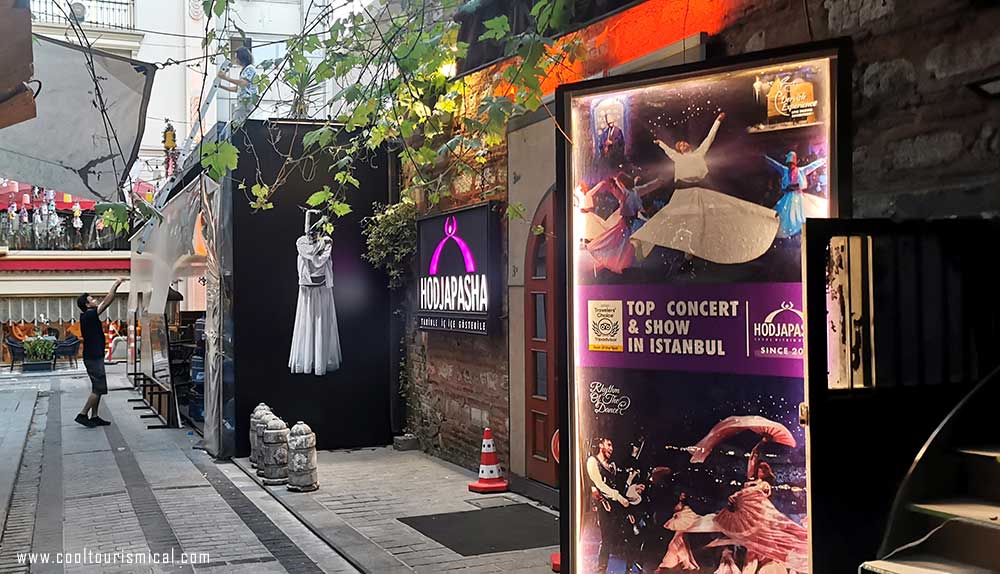
Hodjapasha Entrance – Istanbul, Whirling Dervish Experience, Copyright © Cooltourismical.com
The nearest whirling dervish experience to my accommodation, one of the hotels in Sultanahmet area, was the live show (and exhibition) at Hodjapasha Cultural Center. So, I could say that it was my main criteria of selecting the activity. Of course, along with its historical setting. As an architect, I really think that an amazing space greatly contributes in beautifully shaping a cultural performance. And Hodjapasha seemed to deliver that epic atmosphere I was looking for.
🎟️Buying the Dervish Show Tickets
I wish the story of that evening had begun on a more enchanting note. However, purchasing my tickets for the whirling dervish performance in Istanbul, though it may seem like the practical part of the tale, is just as essential as everything else—perhaps even more.
A week before the show, I got my tickets through Viator for a Saturday evening at 7 pm. They have this magical “reserve now, pay later’ feature, which it always felt like a blessing for me. I adjust my travel schedule a lot and it gives me enough freedom to plan my days and my budget accordingly.
And it really helped me this time also because I could easily change from Saturday to Sunday.
Viator sent me some digital tickets. And the organizer reached out via WhatsApp the day before. They shared the exact location and an entrance code, making the ticket redemption at the HodjaPasha counter seamless.
The seats were numbered, without being able to choose them myself. But luckily I was seated in the second row, perfectly positioned in the middle of the stage. The venue was full, so making the reservation in advance wasn’t a bad idea.
📌Finding the Location
You will find HodjaPasha Cultural Center in the Sirkeci area of Istanbul, not far from the old Orient Express train station and Topkapi Palace. Right in the middle of the lovely noisy and bustling markets of Eminönü.
From the narrow, crowded Tarihi Hocapasa Lokantalari—a covered lane lined with historic fast-food restaurants and shops selling fruit and spices — a smaller street opens up alongside an old stone building, leading to the entrance of the Dervish Show venue. Can’t miss it!
I would say the place is pretty accessible even for first-time visitors, especially if you follow Google maps indications.
🕌 The Venue
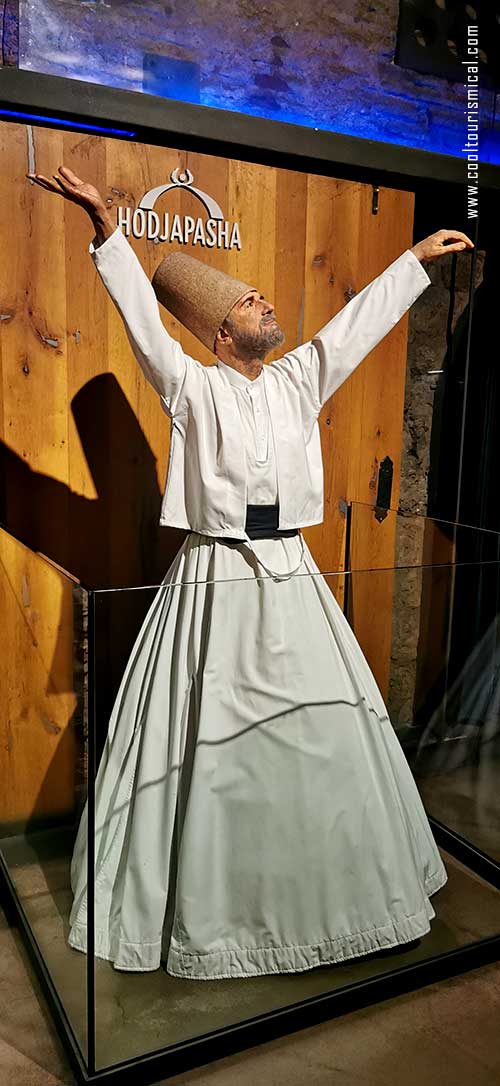
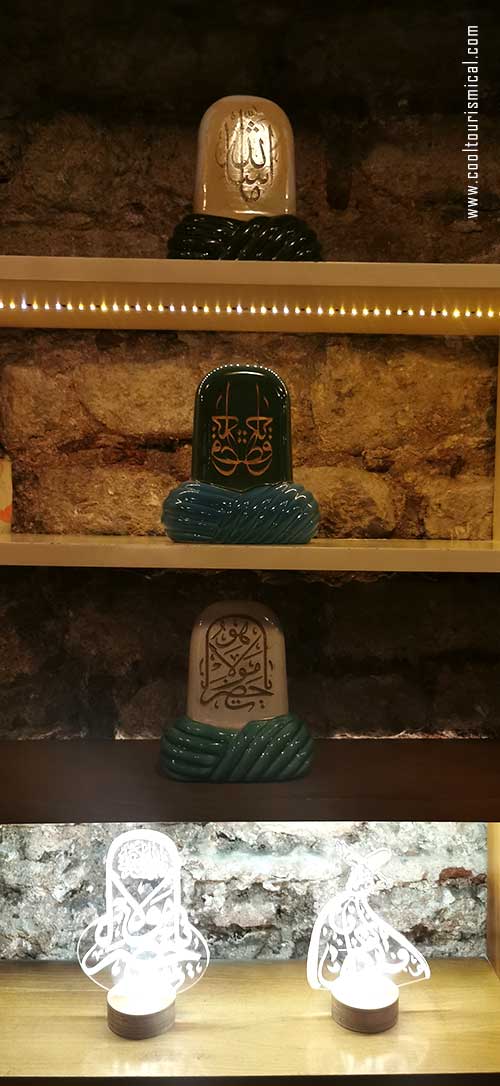
Hodjapasha Museum in Istanbul, Copyright © Cooltourismical.com
Hodjapasha Cultural Center is housed in this beautifully restored 550-year-old Ottoman Turkish bathhouse, once known as the Hocapaşa Hamamı. The building exudes an undeniable and timeless historic charm with its domed roof, red brick and stone walls, some of which have been already gracefully overtaken by tiny, creeping vegetation.
Only one window and a grand entrance pierce the main façade. Beyond the door, the magic begins. A ground floor, more like a corridor, decorated with geometric patterns and a wooden beehive shelf showcasing items for purchase, leads to a staircase at the end.
The stairs open up to a circular, stone-wall room, illuminated by a striking modern metal chandelier hanging above. There’s the ticket counter, a charming shop, and a small museum displaying artifacts and stories about Rumi, the Mevlevi Order, and their traditions, including the Sema Ceremony.
I highly recommend arriving 30–60 minutes early to explore the exhibits and gain some really valuable insights before the actual Whirling Dervish performance.
From the museum, to the right of the stairs, you can enter the performance hall—a small, intimate octagonal room with a domed ceiling. The space is softly lit, and the circular seating arrangement, consisting of 3-4 rows of chairs on different levels, ensures every visitor has a close view of the ceremony. There is a small area reserved for the band and a central stage where the dervishes perform. The domed ceiling and stone arches create exceptional acoustics.
The interiors blend the ancient air of the building itself with modern interventions such as show lights, seating rows and a central lit stage, without diminishing the historical strength.
📌 The Dervish Show at Hodjapasha
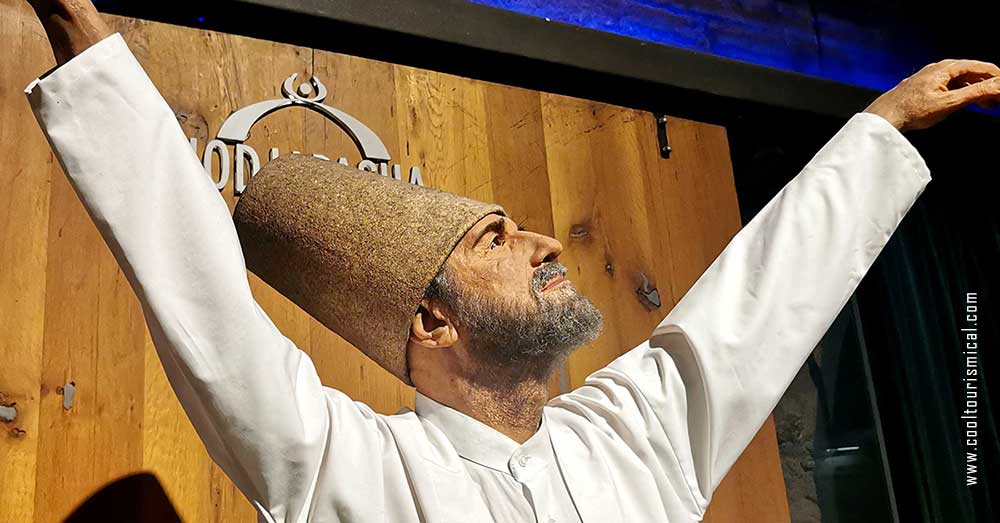
Hodjapasha Museum in Istanbul, Copyright © Cooltourismical.com
For me, it was something new and almost magical.
When I entered the performance hall, people were already whispering. A quiet anticipation was easily taking over the room as everyone settled into their seats and lights dimmed.
A short story of the Sema and the dervishes’ role within it began unfolding on the stone walls, while almost imperceptibly musicians were taking their own places in a corner. Then, the first notes of the ney, a traditional Turkish flute, floated through the space, paired with the steady rhythm of a drum. The music felt somehow haunting and deep, striving to pull the whole audience into a meditative mood.
The dervishes entered the room moving gracefully, wearing their tall, conical hats, and white flowing robes, covered with a black cloth. As they took their positions and removed the black coat, the head dervish performed a ritual bow to mark the beginning of the Sema.
For almost 45 minutes, the dervishes whirled, with their arms caught in the connection between the sacred and the mortal. The right hand pointed upwards, toward the heavens, and the left hand downward, toward the earth while whirling for divine love. Their robes billowed out as they turned effortless, as if they were defying gravity.
The whirling dervish experience can be profound. Or not. However, to fully grasp its depth, it is worth coming a bit earlier. After the show, the place closes almost immediately.
What’s included
- A flyer (at the counter)
- Bottled water (at the counter)
- Entry/Admission – Hodjapasha Cultural Center, show and exhibition
What’s not included
- Food
- Hotel pickup and drop-off
- A Comprehensive Booklet – 250 Turkish Lira extra
Pros
- The venue is just amazing, historic charm and modern accents.
- Accessible location for tourists in Sultanahmet area.
Cons
- Not being allowed to take pictures.
- Closing up to fast after the performance.
 Tips for Attending a Sufi Dance Performance
Tips for Attending a Sufi Dance Performance
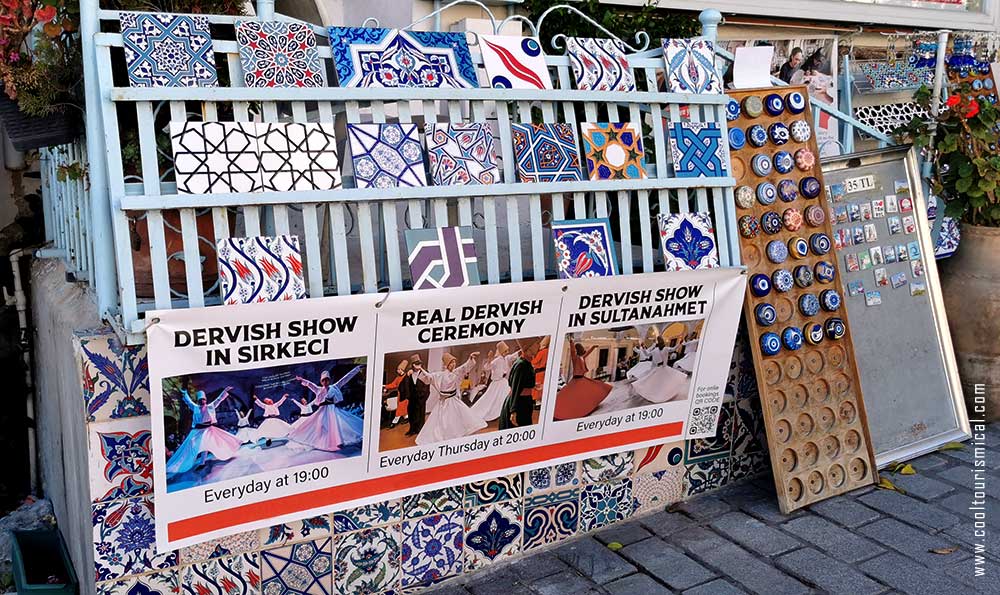
Istanbul street ad, Copyright © Cooltourismical.com
There are a few things to keep in mind when choosing where to watch a dervish performance, – authenticity, etiquette, timing and dress code.
Instead of going for strictly commercial ones, I advise booking a dervish show in a location that still maintains the historical authenticity of the Sema ceremony.
Arrive early! This will guarantee a decent place, especially at venues where you can choose your seats. And it’s also advantageous for people who aren’t familiar with the dervishes because it lets you experience the ambiance and in advance of the show. This is very important for venues like Hodjapasha, where you can explore exhibitions that close after the event.
During the ceremony, due to its strong spiritual nature, most of the venues ask you to keep silent. Also, make sure to enquire about any rules about photography or recording, as some locations might not allow. While there are no strict requirements regarding the dress code, it is better to dress modestly out of respect.
 FAQ
FAQ
Where to buy tickets for the Whirling Dervishes Experience?
In my opinion, it is easier and faster to buy the tickets for Istanbul dervish shows online, on websites like Tiqets, Viator or GetYourGuide, where you can actually see what people think and already experienced. But for some venues, you can only buy at the location.
Who was Rumi?
Jalal ad-Din Muhammad Rumi was a 13th-century Persian poet, Islamic scholar, and Sufi mystic. His poetry, particularly in works like the Masnavi and Divan-e Shams-e Tabrizi, explores themes of love, spiritual enlightenment, unity with the divine, and the transcendent journey of the soul.
Rumi’s connection to the Whirling Dervishes lies in the spiritual practices of the Mevlevi Order, a Sufi order that was founded by his followers after his death. The Whirling Dervishes, or Mevlevis, perform the Sema ceremony, which is inspired by Rumi’s teachings. The whirling dance is a form of active meditation and symbolizes the soul’s ascent toward perfection and unity with God. This practice reflects Rumi’s belief that through music, poetry, and dance, one could transcend the ego and connect with the divine.
How long do dervishes spin for?
Dervishes typically spin for 10 to 30 minutes per session within a Sema ceremony, though the entire ritual, including multiple spinning segments, can extend to over an hour.
Do dervishes get dizzy?
Dervishes are trained to avoid dizziness through years of practice. They focus on a fixed point, often their hand, and maintain a steady, controlled rhythm, which helps them spin for extended periods without experiencing dizziness. The spinning also becomes a meditative state, allowing them to transcend the usual physical limitations that cause dizziness.
Can a woman be a whirling dervish?
Yes, women can indeed be whirling dervishes. Historically, the Mevlevi Order of whirling dervishes was predominantly male, but women have increasingly participated in this spiritual practice, especially in modern times. Reference in the word file
Is the dervish show suitable for children?
it’s important to consider the length and the nature of the ceremony. The show can last around an hour, and it is a religious and meditative ritual rather than a high-energy performance. Younger children or those with shorter attention spans might find it difficult to stay engaged for the entire duration. Children most probably will get bored, especially because thye ar enot allowed to move or speak.
Feel free to leave a comment below if you have any questions that I can answer or if you’d like to share your own experience with the Whirling Dervishes in Istanbul. I’d love to hear from you!

